Vlad III, alternatively known as Vlad Tepes (the Impaler), or more widely recognized as Dracula, took on the role of Wallachia’s ruler on three separate occasions, mainly from 1456 to 1462, throughout the initial wave of Ottoman expansion into the Balkans. He has attained status as a folk hero across various parts of Eastern Europe, attributed to his violent clashes preserving Orthodox Christianity from invading Ottomans. His infamous reputation as “the Impaler” is derived from his preferred method of dispatching his Ottoman adversaries using impalement, a characteristic that has been instrumental in shaping his ominous persona in the realm of popular culture throughout the centuries since his death. Bram Stoker’s esteemed 1897 novel’s lead character, Count Dracula, was inspired by Vlad’s infamous moniker and reputation. He informs virtually every vampire depiction across mediums like movies, TV shows, novels, comics, and video games. It’s important to note that unlike the movie interpretation of vampires, Dracula’s victims were not only innocent people hunted in the nighttime. If history is to believed, Vlad had a distinct fascination with blood. After impaling his enemies, he was reputed to dip bread into their blood and consume it. If your understanding of the real Dracula—the man behind the myth—is confined to this account, brace yourself to uncover 25 Grisly and Bloodthirsty Facts About the True Dracula.
The real historical Dracula was Vlad III (AKA Vlad the Impaler). He was born in Sighisoara, Transylvania, in 1431. A restaurant sits at the site of his birthplace today and receives thousands of tourists annually from all over the world.
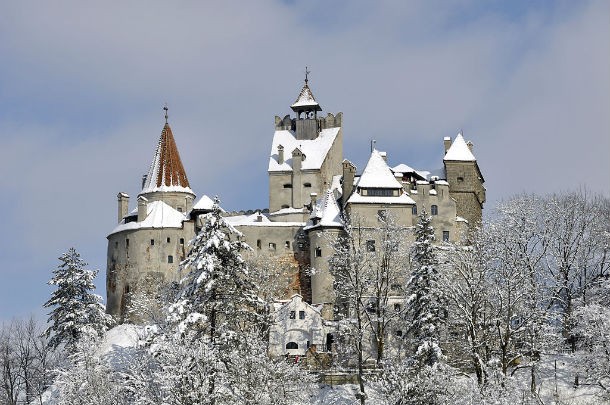 Source: Vlad the Impaler: In Search of the Real Dracula, Image: https://commons.wikimedia.org/wiki/File:Castelul-bran-iarna.jpg
Source: Vlad the Impaler: In Search of the Real Dracula, Image: https://commons.wikimedia.org/wiki/File:Castelul-bran-iarna.jpg Dracula’s father was called Dracul, meaning “dragon” according to some sources, and “devil” according to others, because he belonged to the Order of the Dragon, which fought the Ottoman Empire.
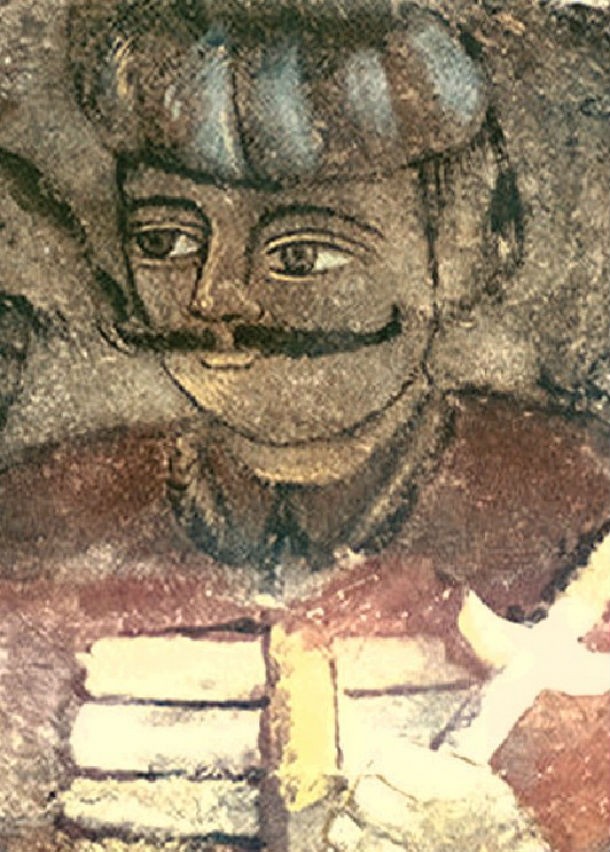 Source: Vlad the Impaler: In Search of the Real Dracula, Image: https://en.wikipedia.org/wiki/Vlad_II_Dracul
Source: Vlad the Impaler: In Search of the Real Dracula, Image: https://en.wikipedia.org/wiki/Vlad_II_Dracul However, Dracula’s mother is unknown, though at the time, his father was believed to have been married to Princess Cneajna of Moldavia. Because he had a number of mistresses at all times, nobody can be sure which was Dracula’s real mother.
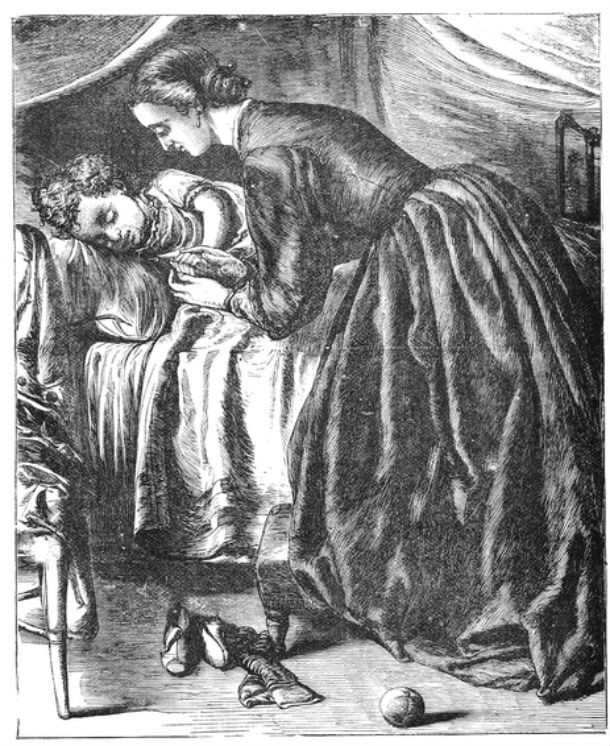 Source: Vlad the Impaler: In Search of the Real Dracula, Image: http://www.reusableart.com/kid-images-18.html
Source: Vlad the Impaler: In Search of the Real Dracula, Image: http://www.reusableart.com/kid-images-18.html Dracula lived in a time of constant war. Transylvania was at the frontier of two great empires: the Ottoman and the Austrian Habsburgs. He was imprisoned at a young age, first by the Turks, who hauled him away in chains, and later by the Hungarians. Dracula’s father was murdered, while his older brother, Mircea, was blinded with red-hot iron stakes and buried alive, two facts that contributed a lot to him becoming so vile and vicious later in life.
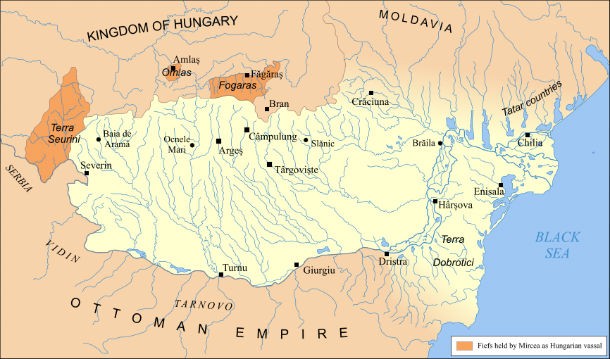 Source: Vlad the Impaler: In Search of the Real Dracula, Image:https://commons.wikimedia.org/wiki/File:Wallachia_cca1390_fr.svg
Source: Vlad the Impaler: In Search of the Real Dracula, Image:https://commons.wikimedia.org/wiki/File:Wallachia_cca1390_fr.svg It is believed that a young Dracula spent some time in Constantinople in 1443 in the court of Constantine XI Palaiologos, a legendary figure of Greek folklore and the final emperor of the Byzantine Empire. It is suggested by some historians that it was there that he developed his hate toward the Ottomans.
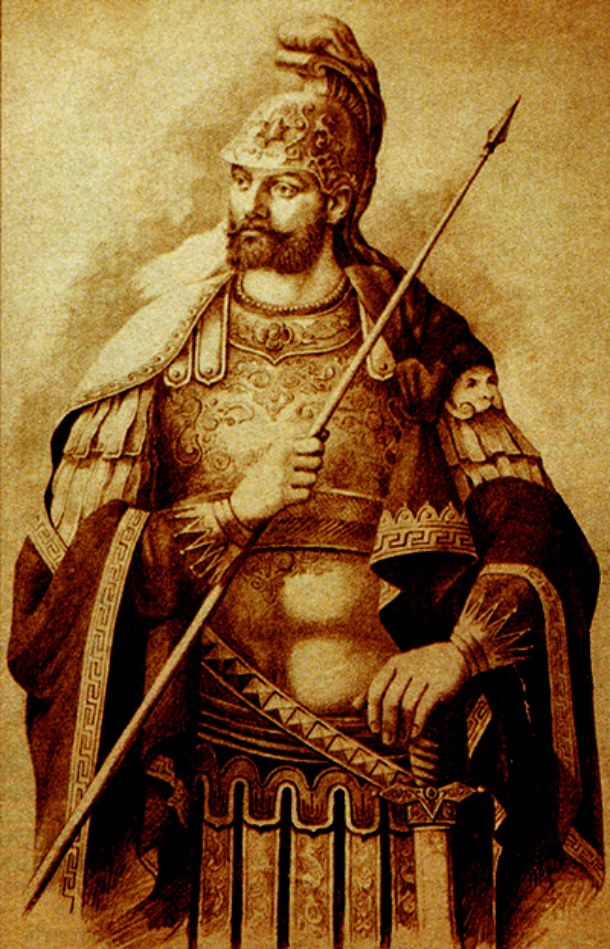 Source: Vlad the Impaler: In Search of the Real Dracula, Image: https://en.wikipedia.org/wiki/Constantine_XI_Palaiologos
Source: Vlad the Impaler: In Search of the Real Dracula, Image: https://en.wikipedia.org/wiki/Constantine_XI_Palaiologos It is believed Dracula was married twice. His first wife’s identity is unknown, though she may have been a Transylvanian noblewoman. She bore his son and heir, Mihnea cel Rau. He married a second time after his period of imprisonment in Hungary. Ilona Szilagyi was the daughter of a Hungarian noble, and she bore him two sons, neither of whom became rulers.
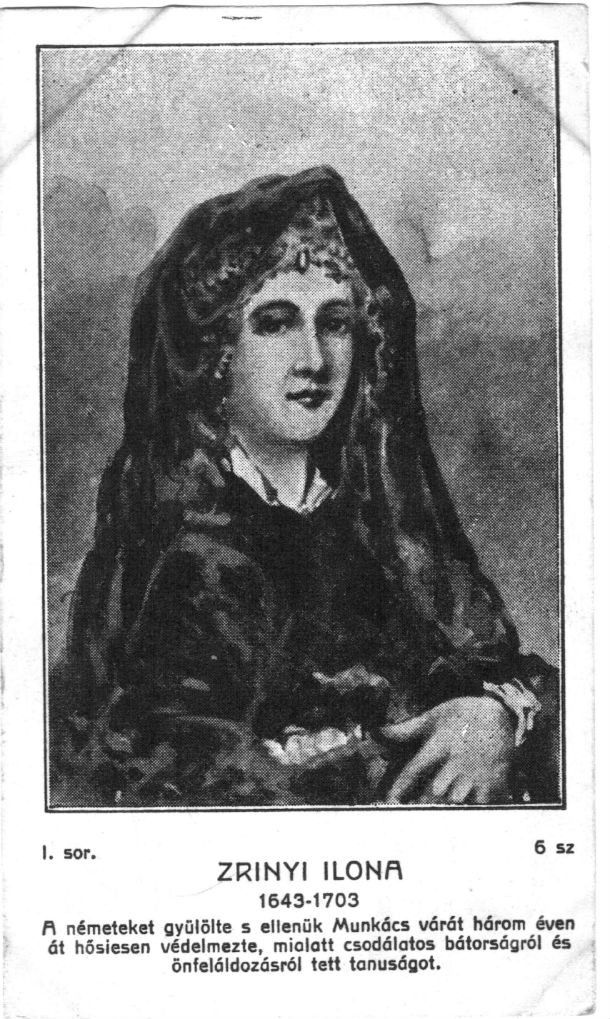 Source: Vlad the Impaler: In Search of the Real Dracula, Image: https://commons.wikimedia.org/wiki/File:6._Zrinyi_Ilona.jpg
Source: Vlad the Impaler: In Search of the Real Dracula, Image: https://commons.wikimedia.org/wiki/File:6._Zrinyi_Ilona.jpg The name Tepes is Romanian for “the Impaler.” It was a title given to him posthumously.
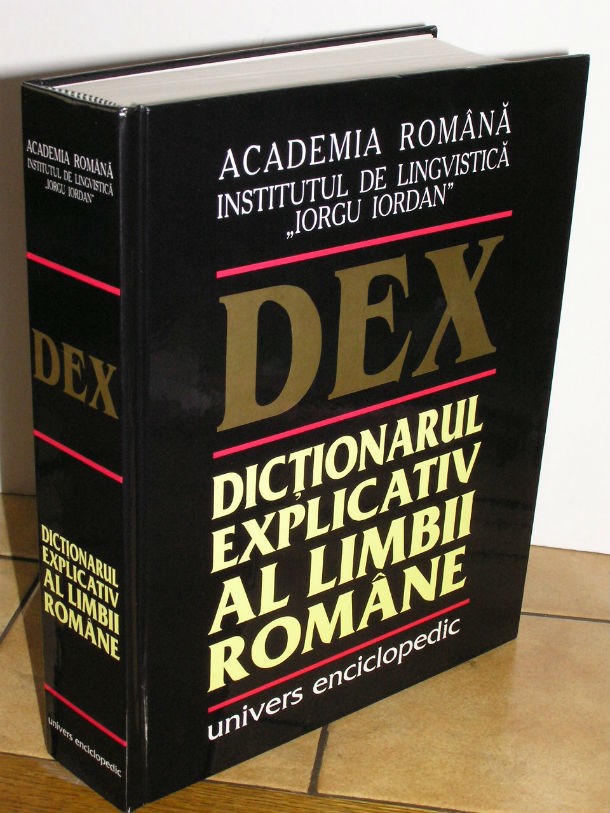 Source: Vlad the Impaler: In Search of the Real Dracula, Image: https://en.wikipedia.org/wiki/Dic%C8%9Bionarul_explicativ_al_limbii_rom%C3%A2ne
Source: Vlad the Impaler: In Search of the Real Dracula, Image: https://en.wikipedia.org/wiki/Dic%C8%9Bionarul_explicativ_al_limbii_rom%C3%A2ne Vlad III earned his “Impaler” moniker by killing thousands of Turks and others by the grisly method that he learned during his teens, when he was a political hostage of the Ottoman Empire in Constantinople.
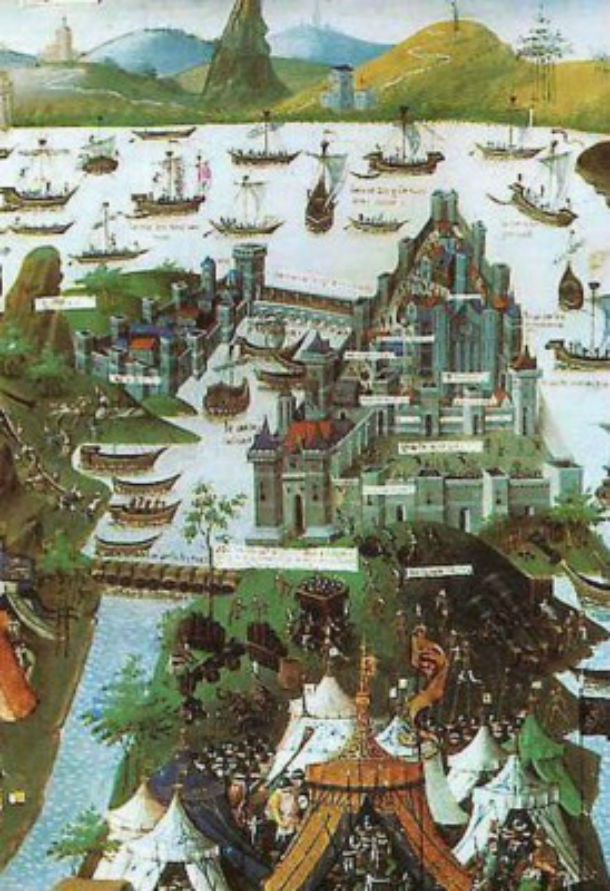 Source: Vlad the Impaler: In Search of the Real Dracula, Image: https://en.wikipedia.org/wiki/Constantinople#/media/File:Constantinople_1453.jpg
Source: Vlad the Impaler: In Search of the Real Dracula, Image: https://en.wikipedia.org/wiki/Constantinople#/media/File:Constantinople_1453.jpg It’s estimated that Dracula was responsible for the death of more than one hundred thousand people (most of them Turks), making him the single most vicious enemy the Ottoman Empire ever faced.
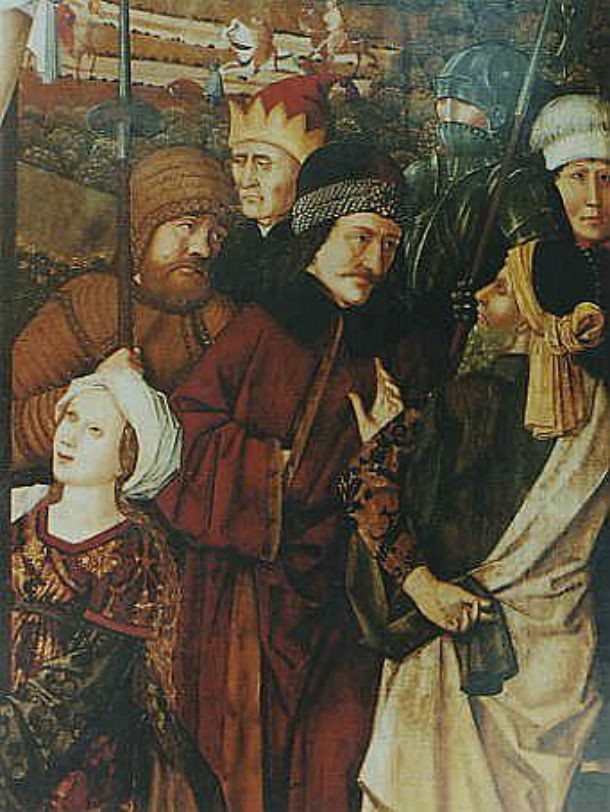 Source: Vlad the Impaler: In Search of the Real Dracula, Image: https://simple.wikipedia.org/wiki/Vlad_III_the_Impaler#/media/File:Tepes4.jpg
Source: Vlad the Impaler: In Search of the Real Dracula, Image: https://simple.wikipedia.org/wiki/Vlad_III_the_Impaler#/media/File:Tepes4.jpg In 1462, while the war between the Ottoman Empire and Dracula’s Wallachia was being waged, Sultan Mehmed II fled with his army, intimidated at the sight of twenty thousand Turkish impaled corpses rotting on the outskirts of Vlad’s capital city of Targoviste.
 Source: Vlad the Impaler: In Search of the Real Dracula, Image: https://en.wikipedia.org/wiki/List_of_campaigns_of_Mehmed_the_Conqueror#/media/File:Sarayi_Album_10a.jpg
Source: Vlad the Impaler: In Search of the Real Dracula, Image: https://en.wikipedia.org/wiki/List_of_campaigns_of_Mehmed_the_Conqueror#/media/File:Sarayi_Album_10a.jpg During one battle, Dracula retreated to nearby mountains, impaling people as he went. This forced the Turkish forces to stop going after him because the sultan could not bear the stench from the decaying corpses.
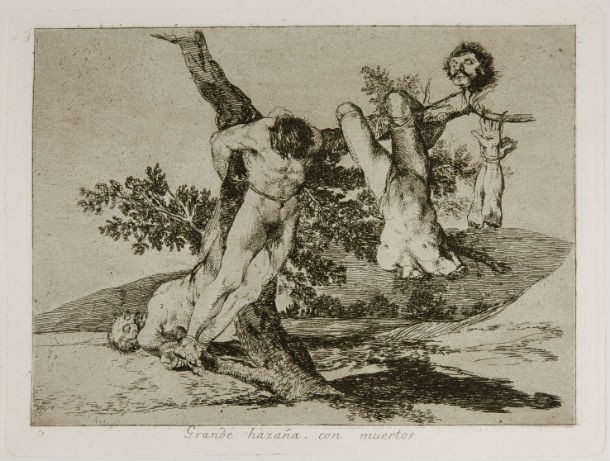 Source: Vlad the Impaler: In Search of the Real Dracula, Image: https://en.wikipedia.org/wiki/The_Disasters_of_War#/media/File:Prado_-_Los_Desastres_de_la_Guerra_-_No._39_-_Grande_haza%C3%B1a,_con_muertos.jpg
Source: Vlad the Impaler: In Search of the Real Dracula, Image: https://en.wikipedia.org/wiki/The_Disasters_of_War#/media/File:Prado_-_Los_Desastres_de_la_Guerra_-_No._39_-_Grande_haza%C3%B1a,_con_muertos.jpg Impaled corpses were displayed as a warning to others, while their white, blood-drained appearance with a visible neck wound perpetuated the notion that Vlad Tepes was a vampire.
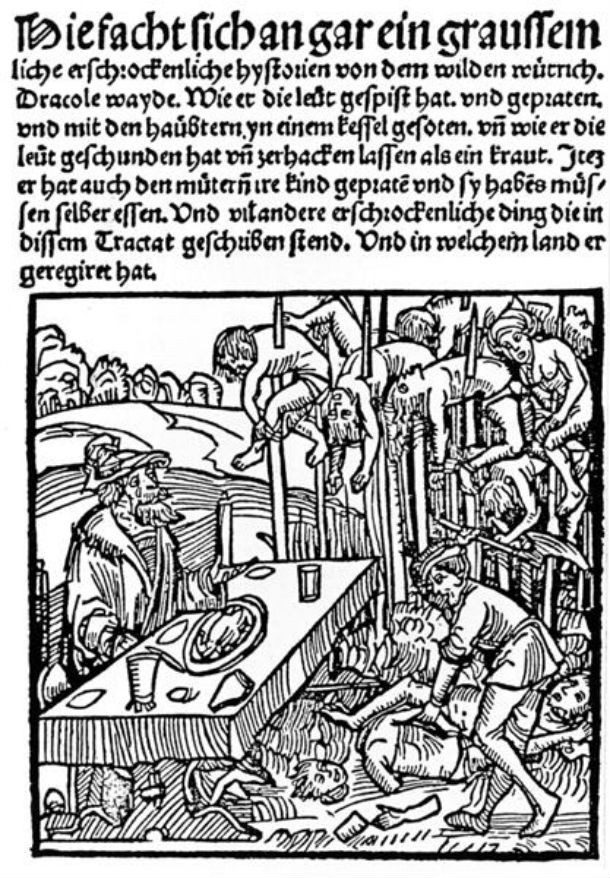 Source: Vlad the Impaler: In Search of the Real Dracula, Image: https://en.wikipedia.org/wiki/Vlad_the_Impaler#/media/File:Impaled.gif
Source: Vlad the Impaler: In Search of the Real Dracula, Image: https://en.wikipedia.org/wiki/Vlad_the_Impaler#/media/File:Impaled.gif During the times he had to retreat so he wouldn’t be captured by his enemies, he would burn down his own villages and murder hundreds of local people along the way so that the Ottoman army would have nowhere to rest or find women to rape.
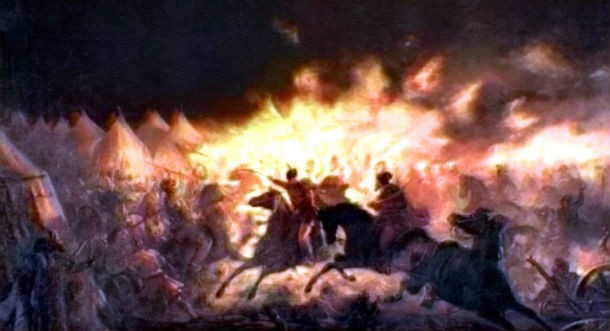 Source: Vlad the Impaler: In Search of the Real Dracula, Image: https://en.wikipedia.org/wiki/Vlad_the_Impaler#/media/File:AtaculdeNoapte.jpg
Source: Vlad the Impaler: In Search of the Real Dracula, Image: https://en.wikipedia.org/wiki/Vlad_the_Impaler#/media/File:AtaculdeNoapte.jpg In an attempt to clean up the streets of the capital of Wallachia (Targoviste), Dracula invited all the sick, vagrants, and beggars over to one of his homes under the pretext of a feast. After they all had a delicious (last) meal, Dracula left, locked them all in, and burned the building to the ground.
 Source: Vlad the Impaler: In Search of the Real Dracula, Image: https://commons.wikimedia.org/wiki/File:Curtea_Domneasca_-_Targoviste_(judetul_Dambovita).jpg
Source: Vlad the Impaler: In Search of the Real Dracula, Image: https://commons.wikimedia.org/wiki/File:Curtea_Domneasca_-_Targoviste_(judetul_Dambovita).jpg When he was older, Vlad was eventually captured and decapitated during a Turkish invasion and his head was given to the sultan, who impaled it outside his palace so everybody could see it.
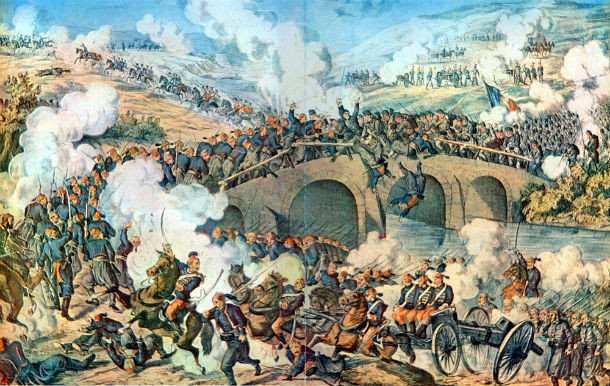 Source: Vlad the Impaler: In Search of the Real Dracula, Image: https://en.wikipedia.org/wiki/Russo-Turkish_War_(1877%E2%80%9378)
Source: Vlad the Impaler: In Search of the Real Dracula, Image: https://en.wikipedia.org/wiki/Russo-Turkish_War_(1877%E2%80%9378) It is believed that archaeologists who were searching for Snagov (commune outside Bucharest) in 1931 found Dracula’s remains. The contents were transferred to the History Museum in Bucharest, but they later disappeared without a trace, leaving the mysteries of the real Prince Dracula unanswered.
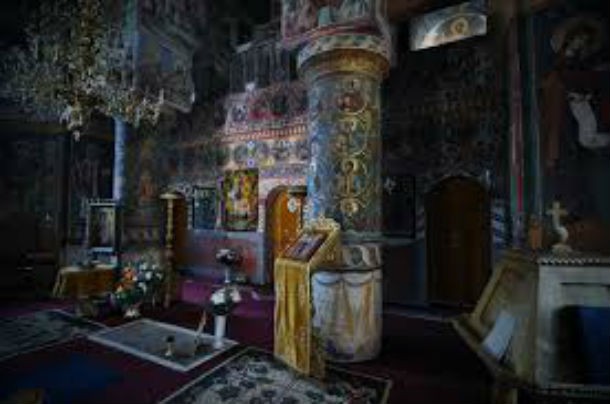 Source: Vlad the Impaler: In Search of the Real Dracula, Image: https://en.wikipedia.org/wiki/Snagov
Source: Vlad the Impaler: In Search of the Real Dracula, Image: https://en.wikipedia.org/wiki/Snagov Despite his cruelty, Dracula was very religious and surrounded himself with priests and monks throughout his life. He founded five monasteries, while it is estimated that during a period of 150 years, his family established over fifty monasteries.
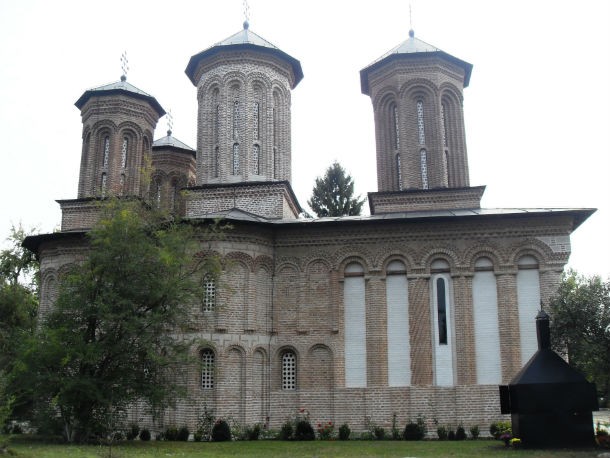 Source: Vlad the Impaler: In Search of the Real Dracula, Image: https://commons.wikimedia.org/wiki/File:Snagov_monastery,_lateral_view.JPG
Source: Vlad the Impaler: In Search of the Real Dracula, Image: https://commons.wikimedia.org/wiki/File:Snagov_monastery,_lateral_view.JPG That’s probably why the Vatican originally praised him for defending Christianity and being so religious, but it would later disapprove of his cruel methods and cut its ties with him.
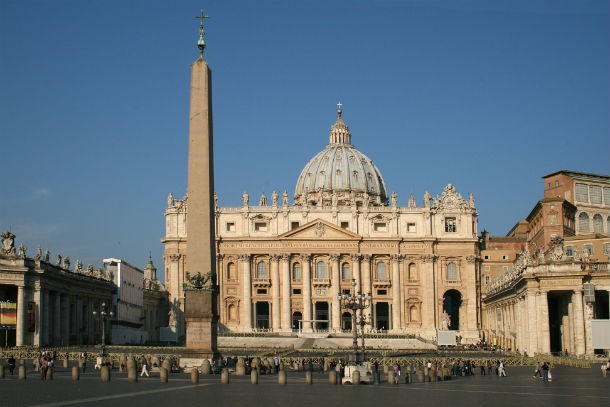 Source: Vlad the Impaler: In Search of the Real Dracula, Image: https://commons.wikimedia.org/wiki/File:0_Place_Saint-Pierre_-_Vatican.JPG
Source: Vlad the Impaler: In Search of the Real Dracula, Image: https://commons.wikimedia.org/wiki/File:0_Place_Saint-Pierre_-_Vatican.JPG In Turkey, Dracula is regarded as a monstrous and vile leader who took gratuitous pleasure in the painful execution of his enemies. However, Russian sources describe his deeds as justified.
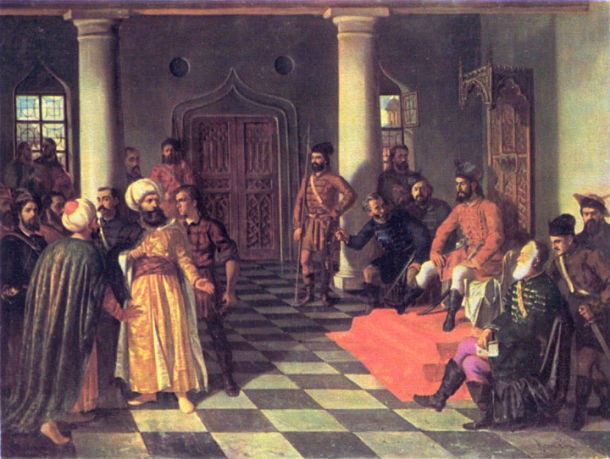 Source: Vlad the Impaler: In Search of the Real Dracula, Image: https://en.wikipedia.org/wiki/Vlad_the_Impaler#/media/File:Theodor_Aman_-_Vlad_the_Impaler_and_the_Turkish_Envoys.jpg
Source: Vlad the Impaler: In Search of the Real Dracula, Image: https://en.wikipedia.org/wiki/Vlad_the_Impaler#/media/File:Theodor_Aman_-_Vlad_the_Impaler_and_the_Turkish_Envoys.jpg Dracula enjoyed enormous popularity during the second half of the twentieth century. More than two hundred films were made featuring Count Dracula, more than any other historical figure (directly or indirectly). At the center of this subculture is the legend of Transylvania, which has become almost synonymous with vampires.
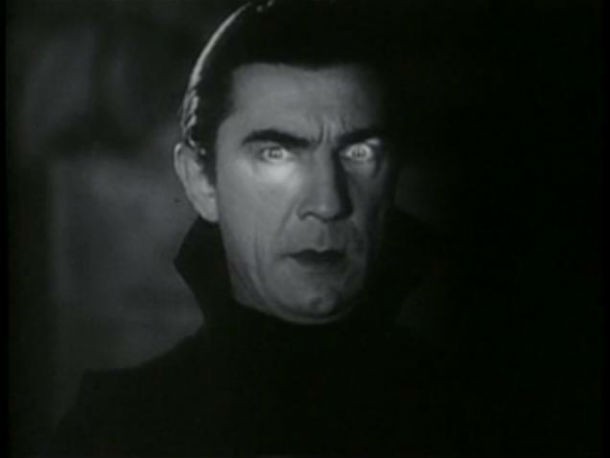 Source: Vlad the Impaler: In Search of the Real Dracula, Image: https://en.wikipedia.org/wiki/Count_Dracula#/media/File:Bela_lugosi_dracula.jpg
Source: Vlad the Impaler: In Search of the Real Dracula, Image: https://en.wikipedia.org/wiki/Count_Dracula#/media/File:Bela_lugosi_dracula.jpg Former Romanian president Nicolae Ceausescu, the communist ruler of the country from 1965 to 1989, promoted Vlad’s patriotism to further his nationalistic agenda, which targeted Hungarians and other ethnic minorities in Transylvania.
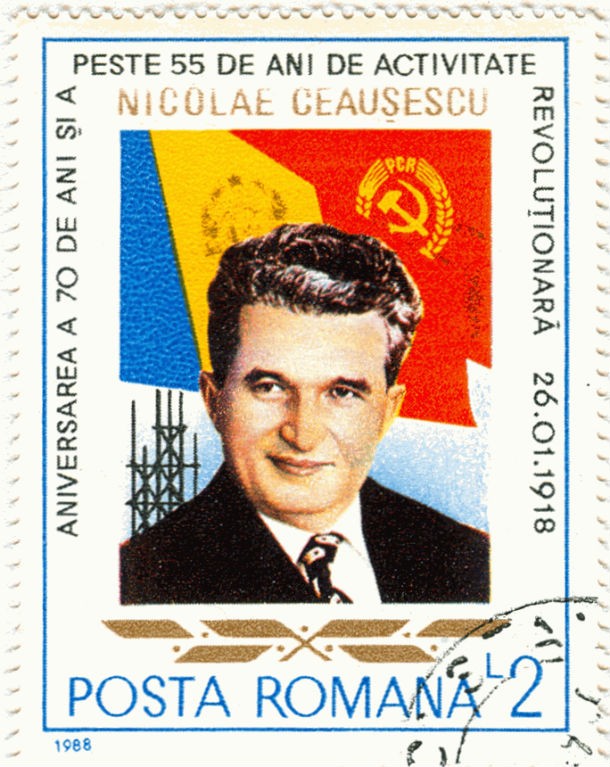 Source: Vlad the Impaler: In Search of the Real Dracula, Image: https://en.wikipedia.org/wiki/Nicolae_Ceau%C8%99escu%27s_cult_of_personality#/media/File:TimbruNicolaeCeausescu.png
Source: Vlad the Impaler: In Search of the Real Dracula, Image: https://en.wikipedia.org/wiki/Nicolae_Ceau%C8%99escu%27s_cult_of_personality#/media/File:TimbruNicolaeCeausescu.png Contrary to popular belief, the vampire is not part of Romanian folklore, and the word is not from the Romanian language. The word derives from the Serbian “vampyr.”
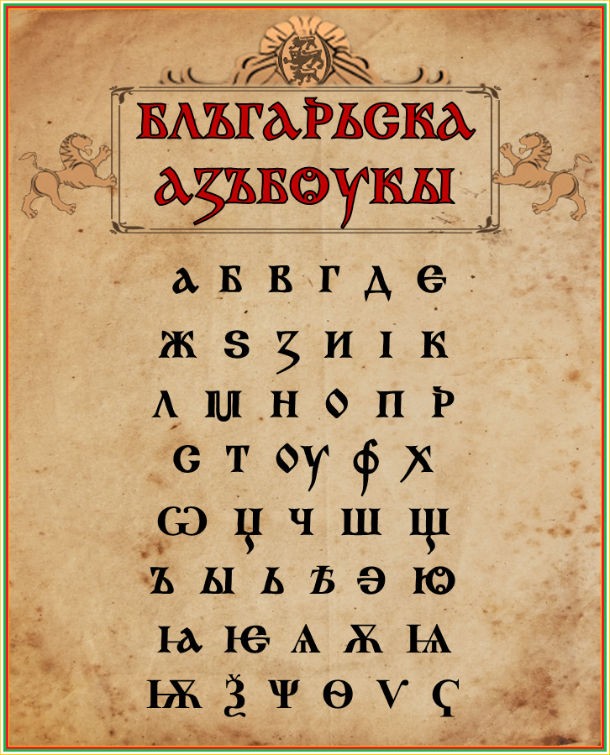 Source: Vlad the Impaler: In Search of the Real Dracula, Image: https://en.wikipedia.org/wiki/National_symbols_of_Bulgaria#/media/File:Old_Bulgarian_Alphabet.png
Source: Vlad the Impaler: In Search of the Real Dracula, Image: https://en.wikipedia.org/wiki/National_symbols_of_Bulgaria#/media/File:Old_Bulgarian_Alphabet.png A contemporary portrait of Vlad III, rediscovered by Romanian historians in the late nineteenth century, had been featured in the gallery of horrors at Innsbruck’s Ambras Castle. The original has been lost to history, but a larger copy, painted anonymously in the first half of the sixteenth century, now hangs in the same gallery. This copy, unlike the crypto-portraits contemporary with Vlad III, seems to have given him a Habsburg lip.
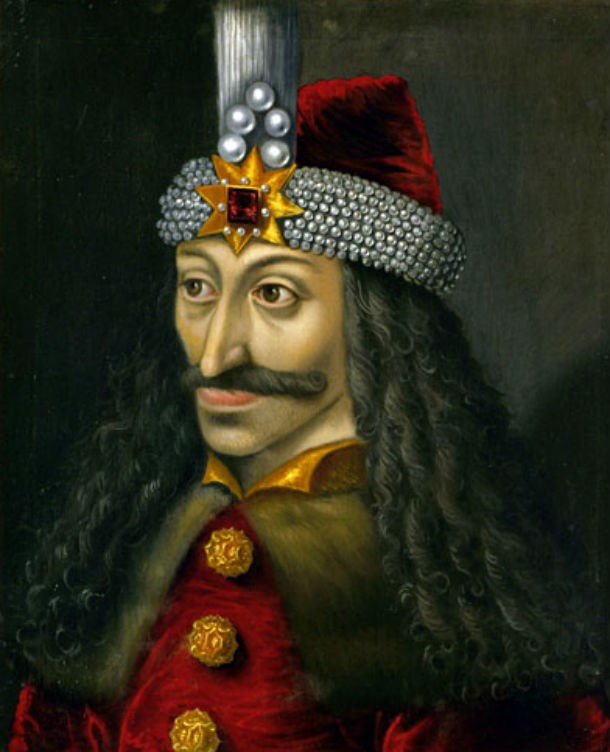 Source: Vlad the Impaler: In Search of the Real Dracula, Image: https://en.wikipedia.org/wiki/Vlad_the_Impaler#/media/File:Vlad_Tepes_002.jpg
Source: Vlad the Impaler: In Search of the Real Dracula, Image: https://en.wikipedia.org/wiki/Vlad_the_Impaler#/media/File:Vlad_Tepes_002.jpg According to the book In Search of Dracula, Vlad had a sense of humor in his own strange way. The book describes how his victims would often twitch around “like frogs” as they were impaled. Vlad found this amusing and according to the book, he once stated about his victims, “Oh, what great gracefulness they exhibit.”
 Source: Vlad the Impaler: In Search of the Real Dracula, Image: https://en.wikipedia.org/wiki/Impalement#/media/File:Empalement.jpg
Source: Vlad the Impaler: In Search of the Real Dracula, Image: https://en.wikipedia.org/wiki/Impalement#/media/File:Empalement.jpg It looks like Dracula was into social experiments way before they became cool. To prove how much his citizens feared him, he placed a gold cup in the middle of the town square in Targoviste. He allowed people to drink from it, but the golden cup had to remain at its position at all times. Amazingly, during his entire reign, the golden cup was never touched, even though the city was inhabited by sixty thousand citizens, most of them living in extreme poverty.
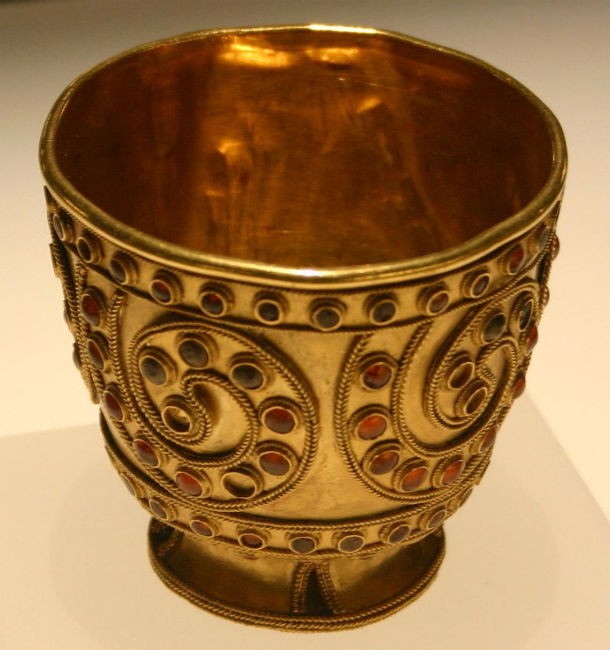 Source: Vlad the Impaler: In Search of the Real Dracula, Image: https://en.wikipedia.org/wiki/Trialeti_culture
Source: Vlad the Impaler: In Search of the Real Dracula, Image: https://en.wikipedia.org/wiki/Trialeti_culture 


























